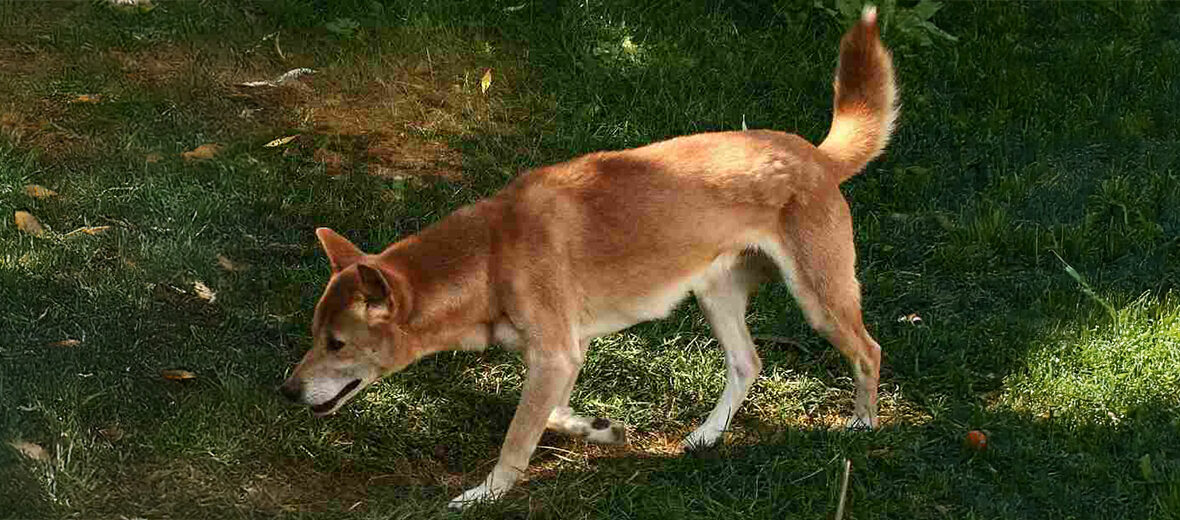
Once thought extinct, the New Guinea singing dog, aka New Guinea Highland dog, Hallstrom’s dog, or singer was recently rediscovered in the New Guinea highlands. They face the threats of poaching, hunting, deforestation, and habitat loss at the hands of residential development and deforestation. While not currently evaluated by the IUCN, they are likely considered Critically Endangered.
First the Stats…
Scientific name: Canis lupus hallstromi
Weight: Up to 31 lbs.
Length: Up to 3 feet
Height: Up to 18 inches, at the shoulders
Lifespan: Up to 15 years
Now on to the Facts!
1.) They were once considered to be a separate species, under the name Canis hallstromi. These canids are closely related to the Australian dingo.
2.) These dogs are quite unusual among canines, as they are 1 of the few canines to be considered “barkless”, and are known for their unusual “yodel”-like style of vocalizing that gives them their name.
3.) In 1989, Tim Flannery, an Australian mammalogist, took a picture of a black-and-tan dog in the Telefomin District. He commented that these dogs lived with local tribal peoples in the mountains, and that feral populations lived in the alpine and sub-alpine grasslands of the Star Mountains and the Wharton Range.
4.) Then in 2012, Australian wilderness-adventure guide Tom Hewett snapped a picture of a tawny, thick-coated dog in the Puncak Mandala region of West Papua, Indonesia.
5.) However, in 2016, a literary review stated that due to these 2 occurrences of these canines being seen in villages that they are actually not wild dogs, but rather domesticated ones.
But wait, there’s more on the New Guinea singing dog!
6.) In 2020, a genetic study discovered that the New Guinea Highland wild dogs were genetically basal to the dingo and the New Guinea singing dog, and thus the potential originator of both species.
7.) In 2019, a workshop hosted by the IUCN/SSC Canid Specialist Group thought the New Guinea singing dog and the dingo were both feral dogs Canis familiaris, and as a result shouldn’t be assessed for the IUCN Red List.
Did you know…?
Seeing as these dogs have only ever been witnessed individually or in pairs, it is therefor surmised that they don’t form formal packs.
8.) By the closing of the last glacial era 11,700 years ago, 5 ancestral lineages had varied from each other and were expressed in ancient dog samples found in the Levant (7,000 YBP), Karelia (10,900 YBP), Lake Baikal (7,000 YBP), ancient America (4,000 YBP), as well as in the New Guinea singing dog (present day).
9.) There are 3 behaviors unique to the singing dog: The head toss (a prompt for attention, food or a sign of frustration); copulatory scream (repetitive sequence of loud, high-pitched yelps lasting about 3 minutes); and copulatory contractions (roughly 3 minutes after the start of the tie, females start a series of rhythmic abdominal contractions).
10.) During estrus (heat), when potential partners are near, same-sex dogs often fight to the extent of severe injury.
But wait, there’s still more on the New Guinea singing dog!
11.) New Guinea singing dogs are so named for their distinctive and melodious howl, which is defined by a sharp increase in pitch at the beginning and very high frequencies at the end.
12.) Howls can last upwards of 5 seconds.
13.) Mid-sized marsupials, rodents, birds, fruits, cuscuses, wallabies, and potentially dwarf cassowaries are all on the menu.
14.) Females undergo up to a 63 day gestation (pregnancy) that yields up to 4 pups.
Now a Short New Guinea Singing Dog Video!
Be sure to share & comment below! Also, check out the Critter Science YouTube channel. Videos added regularly!
Want to suggest a critter for me to write about? Let me know here.
Some source material acquired from: Wikipedia & IUCN
Photo credit: Patti McNeal




